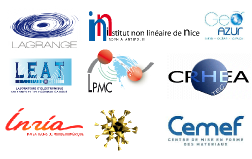Saturne: Formation des satellites à partir d'anneaux massifs et généralisation aux autres planètes du système solaire.
In the rings of Saturn, self gravity is dominated by the tidal forces from the planet. Therefore, the boulders consituting the rings can not aggregate. However, the rings evolve viscously and spread (e.g. Salmon et al. 2010). As they spread beyond the Roche radius, the tides become weaker than the self gravity, and new satellites form. I will describe this process, and show that the smallest moons of Saturn (Prometheus, Pandora, Epimetheus, Janus) most likely formed this way, less than a hundred million years ago (Charnoz et al. 2010) !
Actually, the mid-sized moons of Saturn --namely the 8 ones inside the orbit of Titan-- probably formed this way too : this model explains naturally their partial differentiation and their variable silicate/ice ratio (Charnoz, Crida et al. 2011).
Finally, I'll present an analytical, general model of this process (Crida & Charnoz 2012). We demonstrate that the spreading of rings beyond the Roche radius leads to the formation of a satellite system with a precise mass-distance distribution. This distribution fits very well that of the regular satellites of Saturn. SURPRISE 1: Uranus and Neptune's regular satellites follow the same distribution... Did they have massive rings ? SURPRISE 2: If the rings are more than 1% of the planet mass, our model predicts the formation of 1 single large satellite, like Charon or our Moon !
Conclusion: The spreading of rings beyond the Roche radius may be the most general process of satellite formation in the Solar System.
